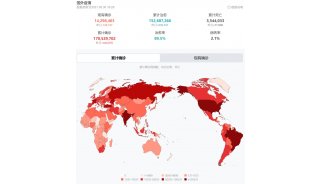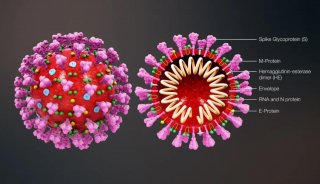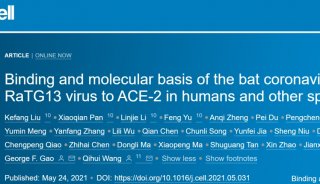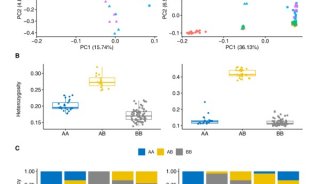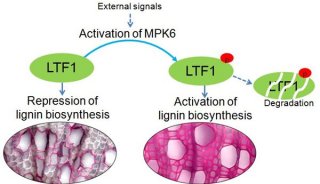Immunity同期刊登中国学者两项成果
来自清华大学医学院,以及中科院生物物理研究所等处的研究人员发表题为“The Adaptor SAP Controls NK Cell Activation by Regulating the Enzymes Vav-1 and SHIP-1 and by Enhancing Conjugates with Target Cells”等两篇文章,分别阐述了X连锁的淋巴细胞异常增生症相关的分子机制,以及STING蛋白结构与功能研究的新成果。
来自生物物理研究所,加州大学洛杉矶分校等处的研究人员利用X-射线晶体学,生物化学和细胞生物学技术,先后解析了STING CTD以及STING CTD与c-di-GMP二元复合物的晶体结构。
阐明了STING CTD形成功能性二聚体的分子机制,文献报道的最后一个跨膜区(153-173aa)其实并不是跨膜区而是STING CTD形成同源二聚体的疏水相互作用界面。STING CTD与c-di-GMP以一种全新的模式结合。
研究人员认为,这一结构是第一个发表的哺乳动物来源的蛋白质与c-di-GMP形成的复合物晶体结构。此外,他们还发现c-di-GMP能促进STING与TBK1结合,诱导I型干扰素的产生,从而激发机体抵抗病原体入侵的免疫反应。
这项研究工作的完成有助于深入了解STING在天然免疫信号通路中的作用,为揭示宿主细胞感知病原菌入侵的分子机制提供了直接的结构生物学证据,同时也为设计新的环鸟苷二磷酸类似物疫苗佐剂或免疫治疗药物奠定基础。
此外另外一篇文章则揭示了和人类免疫系统疾病-X连锁的淋巴细胞异常增生症(XLP disease)相关的分子机制。研究人员发现SAP分子在多种类型的免疫细胞中扮演着重要的角色,而且,他们试图去理解为什么SAP是自然杀伤细胞的重要组分,自然杀伤细胞可以有效清除异常的血细胞。
在这项研究中,研究人员发现SAP是通过双重的机制来激活NK细胞功能的,一方面,SAP可以偶联必要的基因和酶来增强NK细胞的杀伤效应;另一方面,它可以抑制基因产生效应。SAP与大多数XLP病人密切相关,除此之外,这项研究也阐明了SAP在其它疾病诸如狼疮和关节炎等中的作用。
这篇文章由清华大学医学院董忠军研究组与加拿大蒙特利尔临床研究所合作完成,董忠军研究员为第一作者和通讯作者这一。
原文摘要:
Structural Analysis of the STING Adaptor Protein Reveals a Hydrophobic Dimer Interface and Mode of Cyclic di-GMP Binding
STING is an essential signaling molecule for DNA and cyclic di-GMP (c-di-GMP)-mediated type I interferon (IFN) production via TANK-binding kinase 1 (TBK1) and interferon regulatory factor 3 (IRF3) pathway. It contains an N-terminal transmembrane region and a cytosolic C-terminal domain (CTD). Here, we describe crystal structures of STING CTD alone and complexed with c-di-GMP in a unique binding mode. The strictly conserved aa 153173 region was shown to be cytosolic and participated in dimerization via hydrophobic interactions. The STING CTD functions as a dimer and the dimerization was independent of posttranslational modifications. Binding of c-di-GMP enhanced interaction of a shorter construct of STING CTD (residues 139344) with TBK1. This suggests an extra TBK1 binding site, other than serine 358. This study provides a glimpse into the unique architecture of STING and sheds light on the mechanism of c-di-GMP-mediated TBK1 signaling.
The Adaptor SAP Controls NK Cell Activation by Regulating the Enzymes Vav-1 and SHIP-1 and by Enhancing Conjugates with Target Cells
The adaptor SAP, mutated in X-linked lymphoproliferative disease, has critical roles in multiple immune cell types. Among these, SAP is essential for the ability of natural killer (NK) cells to eliminate abnormal hematopoietic cells. Herein, we elucidated the molecular and cellular bases of this activity. SAP enhanced NK cell responsiveness by a dual molecular mechanism. It coupled SLAM family receptors to the kinase Fyn, which triggered the exchange factor Vav-1 and augmented NK cell activation. SAP also prevented the inhibitory function of SLAM family receptors. This effect was Fyn independent and correlated with uncoupling of SLAM family receptors from the lipid phosphatase SHIP-1. Both mechanisms cooperated to enable conjugate formation with target cells and to stimulate cytotoxicity and cytokine secretion by NK cells. These data showed that SAP secures NK cell activation by a dichotomous molecular mechanism, which is required for conjugate formation. These findings may have implications for the role of SAP in other immune cell types.













